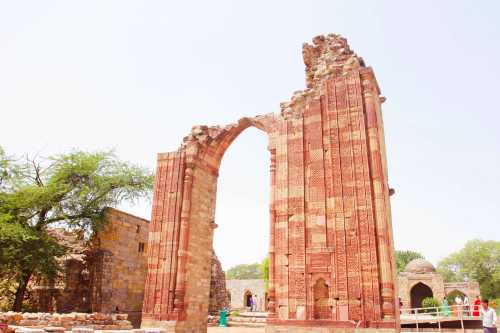Popular Trip Moments
Biggest mosque in New Delhi | New Delhi airport: what to expect | Echoes of Empire: The Resting Place of a Mughal Dream | Whispers of Time: The Tower That Touched the Sky | Full of Indian Vibes! Overflowing Energy | Isa Khan's Tomb in India | 🏰🔥 [The crimson fort where you can feel the history of India] Lal Qila (Red Fort) | Delhi | An Oasis of Relaxation in the Heart of the City | Asia’s Largest Tulip Garden: Indira Gandhi Memorial Tulip Garden, Srinagar | Delhi, One Visit is Never Enough | Discovering Serenity in the Heart of Delhi: Safdarjung Tomb | Discovering Isa Khan’s Tomb – A Hidden Mughal-Era Gem in Delhi | Rediscovering Legacy: A Walk Through Isa Khan’s Tomb | Timeless Majesty at Humayun’s Tomb, Delhi | Timeless Beauty in Stone – My Visit to Humayun’s Tomb | Rediscovering History at the Majestic Red Fort | The Taj Mahal Hotel: A Luxurious Experience in New Delhi | Air India flight review to Leh Ladakh 🇮🇳☺️ | EP.1 Kashmir Trip What time will I become a tourist? 🇮🇳 | 5 recommended spots around New Delhi | The Tale of The Imperial Red Fort 🐉 | New Delhi Travel Guide: A Wild Adventure of Curry, Ancient Sites, and Auto-rickshaws | India - Stay at Welcomhotel by ITC Hotels, Dwarka, New Delhi | Enjoy Sports Events at Delhi's Largest Stadium! | A magnificent ruin built in the 14th century! A fort filled with historical romance. | Delhi's oldest Islamic architectural site! | Learn more about Indian traditional crafts and culture🇮🇳 | A moment of calm in a peaceful Buddhist garden⛲️ | India's largest zoo for families to enjoy | A relaxing park surrounded by greenery in India 🇮🇳
Recommended Attractions at Popular Destinations
Bangkok attraction near me | Manila attraction near me | Tokyo attraction near me | Taipei attraction near me | Hong Kong attraction near me | Seoul attraction near me | Kuala Lumpur attraction near me | Los Angeles attraction near me | Shanghai attraction near me | New York attraction near me | Shenzhen attraction near me | Osaka attraction near me | Singapore attraction near me | London attraction near me | Guangzhou attraction near me | San Francisco attraction near me | Beijing attraction near me | Macau attraction near me | Bali attraction near me | Jakarta attraction near me | Paris attraction near me | Ho Chi Minh City attraction near me | Istanbul attraction near me | Phuket attraction near me | Chicago attraction near me | Seattle attraction near me | Toronto attraction near me | Orlando attraction near me | Cebu attraction near me | Chiang Mai attraction near me
Popular Attractions
The Lost Chambers Aquarium | Dubai Butterfly Garden | Petronas Twin Towers | Leonardo da Vinci Museum of Science and Technology | The Bund | Universal Studios Japan | Shen's Garden | Skydive Dubai | Sky Views Observatory | Mount Batur | Global Village | Carnival Magic Phuket | Genting Highlands Premium Outlets Cable Car | Zhangye National Desert Sports Park | Big Bus Muscat | Singapore Flyer | The Huangpu River Cruise | Wangfujing | Lusevera Ethnographic Museum | Temple | Terry Fox Park | Dandabah camping area, Bunya Mountains National Park | Alpensia 700 GC | Igreja da Areosa | Vizhinjam Rock Temple | Zane Sports Park Soccer Fields | Leids skatepark | Masjid Al Munawar | The Yellow River Scenic Area of Zhengzhou | Foreigner Street
Popular Restaurants in Delhi
Bukhara | Gulati Restaurant, Pandara Road | Khan Chacha(Connaught Place) | Sagar Ratna | United Coffee House | The Spice Route | Saravana Bhavan | Pindi | K3 - New Delhi's Food Theatre | Kiyan | Dakshin | K & K | Tian - Asian Cuisine Studio | Dum Pukht | Kheer | 24/7 | Spicy Duck | Tamra Restaurant | Veda | Lodi The Garden Restaurant | Keventer's(Select Citywalk Mall) | Karim's | The China Kitchen | Zizo | Nirulas | Ottimo At The West View | Baluchi - A Pan Indian Destination | Orient Express | Jamavar | Barbeque Nation(Janakpuri)
Popular Ranked Lists
Top 7 Luxury Hotels in Galle | Popular Must-Visit Restaurants in Paris | Top 3 Best Things to Do in Fuding | Popular Must-Visit Restaurants in Kuala Lumpur | Popular Luxury Hotels Near Fort William | Top 3 Best Things to Do in Xinxiang | Popular Must-Visit Restaurants in Shanghai | Popular Best Things to Do in Wenshan Prefecture | Top 10 Local Restaurants in Stockholm | Popular Luxury Hotels Near Fukushima | Top 6 Best Things to Do in Bijie | Popular Luxury Hotels in Oslo | Popular Premium Hotels Near Dearborn | Top 5 Best Things to Do in Taizhou | Popular Luxury Hotels in Wilaya de Fes | Top 3 Best Things to Do in Xuchang | Top 7 Best Things to Do in Benxi | Top 7 Best Things to Do in Enshi Prefecture | Top 4 Best Things to Do in Xingyi | Popular Best Things to Do in Linhai | Popular Must-Visit Restaurants in Osaka | Top 10 Local Restaurants in Valletta | Popular Must-Visit Restaurants in Singapore | Top 3 Luxury Hotels in Al Madinah | Top 10 Luxury Hotels in Red Sea Governorate | Popular Must-Visit Restaurants in Milan | Popular Must-Visit Restaurants in Florence | Popular Must-Visit Restaurants in Chiang Mai | Popular Luxury Hotels Near Jezerce | Popular Must-Visit Restaurants in Bali
Payment Methods
Our Partners
Copyright © 2025 Trip.com Travel Singapore Pte. Ltd. All rights reserved
Site Operator: Trip.com Travel Singapore Pte. Ltd.
Site Operator: Trip.com Travel Singapore Pte. Ltd.





















